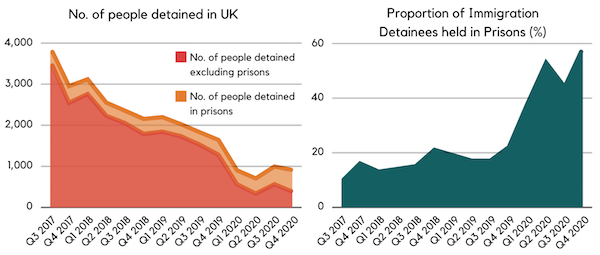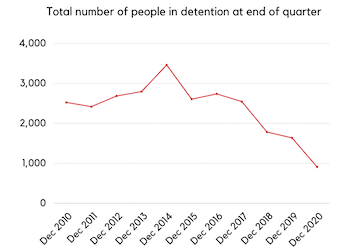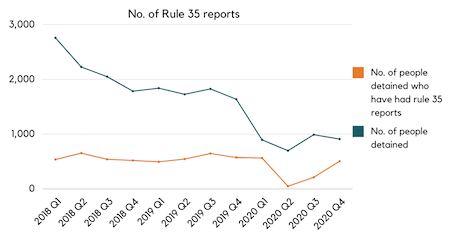2020: A year in detention
 Hidden behind and within the global health crisis last year, we observed some worrying changes on the ground affecting people in immigration detention in the UK. You can read our summary of the government’s most recent immigration statistics here but in this blog we wanted to take a deeper delve into the numbers to see how they correlate with the experiences of our network for the year ending in December 2020. From our perspective, 2020 was characterised by increased isolation for people detained during the pandemic, reduced access for volunteer groups and other NGOs providing support inside detention centres and a shocking increase in the proportion of people detained in prisons.
Hidden behind and within the global health crisis last year, we observed some worrying changes on the ground affecting people in immigration detention in the UK. You can read our summary of the government’s most recent immigration statistics here but in this blog we wanted to take a deeper delve into the numbers to see how they correlate with the experiences of our network for the year ending in December 2020. From our perspective, 2020 was characterised by increased isolation for people detained during the pandemic, reduced access for volunteer groups and other NGOs providing support inside detention centres and a shocking increase in the proportion of people detained in prisons.
During the first lockdown, the government released people from detention at an unprecedented rate and the number of people held in detention centres fell to 330 by June 2020, the lowest point in the last decade.
 Custodial settings of all forms provide conditions that have been described by global public health specialists as ‘amplifying’ the risk of COVID 19 infections. On 18 March, Detention Action issued a legal challenge to the continued detention of many hundreds during the pandemic. While the legal challenge was ultimately dismissed, it did result in some significant concessions from the Home Office including the release of almost 1,000 people. At the end of June, there were only 330 people held in detention centres in the UK, with an additional 368 people detained in prisons, representing the lowest number of people detained in the last decade. At this time, just 9 women were held in the only detention centre for women, the notorious Yarl’s Wood in Bedfordshire. Occupancy was so low that Yarl’s Wood was redesignated to hold people seeking asylum who had arrived via small boat crossings. Even then, Yarl’s Wood held only 66 people in September 2020, despite having bed spaces for 410.
Custodial settings of all forms provide conditions that have been described by global public health specialists as ‘amplifying’ the risk of COVID 19 infections. On 18 March, Detention Action issued a legal challenge to the continued detention of many hundreds during the pandemic. While the legal challenge was ultimately dismissed, it did result in some significant concessions from the Home Office including the release of almost 1,000 people. At the end of June, there were only 330 people held in detention centres in the UK, with an additional 368 people detained in prisons, representing the lowest number of people detained in the last decade. At this time, just 9 women were held in the only detention centre for women, the notorious Yarl’s Wood in Bedfordshire. Occupancy was so low that Yarl’s Wood was redesignated to hold people seeking asylum who had arrived via small boat crossings. Even then, Yarl’s Wood held only 66 people in September 2020, despite having bed spaces for 410.
With these releases, and with so few people detained, we caught a glimpse of a future without detention, where people could be supported in the community as their immigration case was being resolved. However, by September, the number of people in detention overall had risen again, as had the number of women and the number of people detained in prisons. The Home Office also began repurposing ex-military barracks to introduce a concerning form of quasi-detention for hundreds of people seeking sanctuary who had newly arrived and not yet had a chance to make an asylum claim. In another worrying shift, by the end of 2020, the proportion of people detained in prison represented 57% of the people detained under immigration powers in the UK overall. In its standards on the treatment of persons deprived of their liberty, the European Committee for the Prevention of Torture describes the use of prisons to hold people under immigration control as ‘fundamentally flawed'. This shocking figure shows just how far the balance has tipped in the UK towards detention in prison becoming the norm, rather than an exception.

HMIP make it very clear in their recommendation that “Immigration detainees should only be held in prison in very exceptional circumstances following risk assessment and with the authority of an immigration judge.” We believe the routine use of prisons to hold people under immigration powers post-sentence is entirely inappropriate. People held in prisons face a number of barriers to justice and other supports under usual circumstances. A High Court judge has now ruled that the lack of access to legal aid advice for people detained in prison is actually unlawful. It has been widely reported that structural injustice has led to disproportionately negative health outcomes in the pandemic for people in black, Asian and minority ethnic communities. For people in detention in prison, structural racism in the criminal justice system combined with the Home Office’s hostile environment policies that disproportionately target and criminalise non-white non-British nationals, further compound barriers to justice and to health equality.
“When you are detained under immigration powers in a prison, even the benefits of the duty of care shown by the prison to prisoners evaporate” – Michael Darko, AVID Trustee and campaigner with lived experience of detention
During the pandemic, prisons have been subject to particularly strict lockdown regimes in which many people were kept in their cells for upwards of 22 hours a day. People in detention centres also experienced extended periods of isolation, which is known to have dramatic negative mental health impacts, as this is what social distancing amounts to in custodial settings. Government immigration statistics also show that the proportion of people in detention who have made an asylum claim at some point has risen dramatically from 50% in 2010 to 67% in 2020. Meanwhile, the number of Rule 35 reports (the key mechanism for release from detention if someone is particularly at risk as a survivor of torture, trafficking or has other particular vulnerabilities) has remained fairly constant since 2018 despite a worrying drop at the start of the pandemic, meaning a larger proportion of those detained are displaying such indicators.

All this has occurred in a context of reduced access for volunteers and visitors, who are often the only contact someone in detention has with the outside world. Our response as a network has been to support our members where possible to continue supporting people in detention over phone or video call. And amazing work has been done, with hundreds of people in detention having been supported remotely throughout 2020.
But with reduced access comes reduced scrutiny. We are aware of the risk that measures aimed at containing the pandemic can also veil discriminatory practices, as the enforcement of lockdown measures in facilities such as Napier barracks and hotel contingency accommodation for asylum seekers have shown. As one judge found recently, the pandemic should never be used as a cover for delays in releasing someone from detention. With a proposal to build the first new detention centre in 7 years, the start of 2021 has already seen a complete U-turn on government commitments to reduce the number of people held in detention overall, most notably the commitments made following the intensive, government commissioned ‘Shaw reviews’ into the welfare in detention of vulnerable people. The abandonment of post-Shaw commitments is a grave concern.
The proposed new centre in county Durham would have space for up to 80 women and, notably, the plans were drawn up before the evaluation of the Action Access alternative to detention pilot for women has been published. There is mounting evidence from within and outside the UK that holistic, community-based case management approaches can resolve people’s cases more humanely and cost a lot less than the £97.66 the Home Office currently spends daily to keep someone in detention. And so, we begin 2021 much as we began 2020, by calling for more transparency as well as more engagement with civil society and people with lived experience of detention on the issues that matter.
In 2020 we saw that detaining fewer people works better for everyone, so why detain anyone at all?




